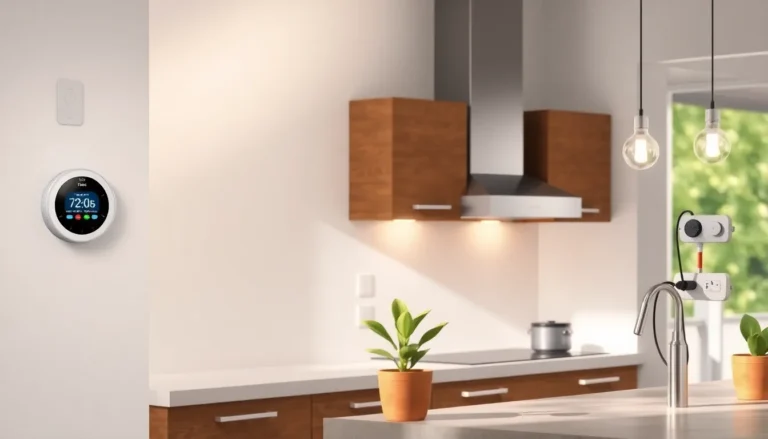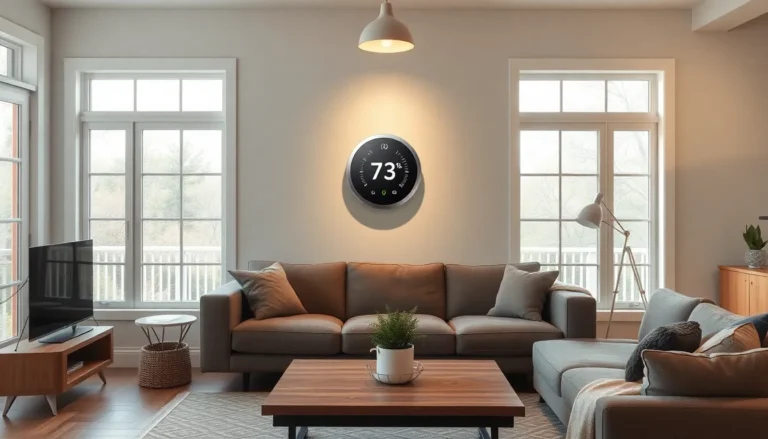Table of Contents
ToggleIn the bustling world of dining, the atmosphere can make or break a meal. Imagine stepping into a restaurant that feels like a cozy hug or an Instagram-worthy dreamscape. Restaurant design concepts play a crucial role in creating that unforgettable experience. After all, who doesn’t want to sip a cocktail in a place that looks like it was plucked straight from a Pinterest board?
From quirky themes that spark joy to sleek modern aesthetics that scream sophistication, the right design can transform a simple meal into a culinary adventure. It’s not just about the food; it’s about the vibe. So let’s dive into the world of restaurant design concepts, where creativity meets functionality, and every corner tells a story. Get ready to explore how the perfect blend of style and comfort can leave diners coming back for more—because who wouldn’t want to eat in a place that feels like home, but with better lighting?
Overview of Restaurant Design Concepts
Restaurant design concepts play a crucial role in creating an appealing dining atmosphere. These concepts range from themes that reflect a particular culture to modern styles that favor minimalism. Incorporating colors, textures, and layouts directly impacts diners’ emotions, enhancing their overall experience.
Effective layout design ensures optimal flow and functionality. Seating arrangements should accommodate various group sizes, allowing for flexibility. Lighting choices set the mood, creating warmth or a vibrant ambiance. For instance, soft lighting fosters intimacy, while brighter lights can encourage faster dining experiences.
Materials and finishes significantly affect the restaurant’s aesthetic. Natural elements, like wood and stone, convey warmth. On the other hand, sleek metals and glass provide a contemporary vibe. Additionally, incorporating artwork or decor aligns with the chosen theme and adds personal touches.
Acoustics play an essential part in design considerations. Noise levels can influence conversation and comfort. Strategies such as sound-absorbing materials contribute to a pleasant dining environment.
Outdoor dining options enhance the overall experience. Incorporating patios or gardens provides fresh air and ambiance. Seasonal changes can keep the space relevant and appealing year-round.
Sustainability increasingly influences restaurant design concepts. Using eco-friendly materials and energy-efficient systems attracts environmentally conscious diners. This commitment to sustainability reflects positively on the restaurant’s brand image.
Understanding these elements helps restaurateurs craft unique concepts that resonate with customers. Thoughtful design leads to memorable dining experiences, encouraging patrons to return. Emphasizing the importance of aesthetics and functionality creates a symbiotic relationship between the restaurant and its guests.
Importance of Effective Restaurant Design
Effective restaurant design plays a crucial role in creating memorable dining experiences. A visually appealing and inviting atmosphere enhances customer enjoyment and satisfaction.
Enhancing Customer Experience
Thoughtful design contributes significantly to customer experience. Comfortable seating arrangements accommodate various group sizes. Welcoming atmospheres encourage patrons to relax and enjoy their meals. Carefully chosen lighting creates a mood that complements the menu. Unique themes capture diners’ interest and heighten engagement. A well-planned layout promotes smooth movement throughout the space, minimizing congestion. Elements such as color, texture, and sound further enrich the environment, making dining enjoyable.
Influencing Brand Identity
Strong restaurant design shapes brand identity. Visual aesthetics reflect the restaurant’s theme and target clientele, establishing a unique presence in the market. Consistent design elements across all platforms reinforce brand recognition. Creative themes create emotional connections, making diners more likely to return. Clear branding through interior designs, menus, and staff uniforms conveys values clearly. Distinctive environments resonate with customers, setting the restaurant apart from competitors. By focusing on design, restaurateurs can leave lasting impressions that define their brand.
Key Elements of Restaurant Design
Effective restaurant design hinges on several critical elements that enhance the dining experience. These components work cohesively to create an inviting and engaging atmosphere for diners.
Layout and Flow
Successful layouts prioritize ease of movement and the dining experience. They accommodate various group sizes while ensuring optimal flow. Open spaces encourage social interaction, while semi-private areas provide intimacy. Separate zones for dining, waiting, and bar services enhance functionality. Designers often use pathways to guide patrons intuitively, reducing congestion and enhancing comfort. Careful arrangement of seating fosters a seamless experience, ensuring diners feel welcomed and valued.
Lighting and Ambiance
Lighting plays a vital role in setting the mood for restaurant diners. Natural light enhances warmth during the day, creating an inviting environment. Soft, dim lighting transforms the ambiance for evening meals, promoting relaxation. Specific fixtures can highlight focal points like artwork or feature walls, enriching the visual experience. Color temperature influences emotions, with warm tones evoking comfort and cool tones suggesting modernity. Selecting the right lighting encourages patrons to linger longer, impacting their overall satisfaction.
Furniture and Decor
Choosing furniture and decor significantly influences the restaurant’s aesthetic and functionality. Comfortable seating encourages patrons to enjoy their meals without feeling rushed. Unique decor elements reflect the restaurant’s theme, providing visual interest and storytelling opportunities. Material selection ranges from rustic wood to sleek metal, aligning with the desired ambiance. Tables should facilitate easy conversation while maintaining space for diners. Thoughtful decor choices reinforce brand identity, helping to create a memorable and distinctive atmosphere that attracts repeat customers.
Popular Restaurant Design Trends
Current trends in restaurant design reflect modern dining preferences. These include sustainability, open kitchen concepts, and creative themes that enhance the overall experience.
Sustainable Design
Sustainable design focuses on eco-friendly materials and practices that reduce environmental impact. Using reclaimed wood, recycled metals, and energy-efficient lighting creates a green atmosphere. Spaces designed with biophilic elements, such as indoor plants and natural light, promote both comfort and wellness. Eco-conscious diners appreciate restaurants that communicate a commitment to sustainability through visible design choices. Implementing water-saving fixtures and composting systems also supports environmentally friendly goals.
Open Kitchen Concepts
Open kitchen concepts allow diners to witness food preparation, heightening their engagement. These designs promote transparency and communicate freshness and quality. Chefs can interact directly with guests, creating a unique, interactive dining experience. This layout fosters a sense of community within the space. By utilizing glass panels or partial walls, restaurants maintain an inviting atmosphere while reinforcing their brand image. The visual connection to the cooking process enhances diners’ appreciation for culinary craftsmanship.
Themed Restaurants
Themed restaurants transport guests to unique experiences through creative designs. Each theme influences decor, menu, and ambiance, immersing diners in a specific narrative. Popular themes may include vintage, tropical, or cultural motifs that evoke certain memories or emotions. Color palettes and design elements play crucial roles in creating cohesive environments. Diners often seek out these distinctive experiences, making thematic design essential for attracting patronage. This approach enhances brand identity and encourages memorable visits, driving repeat business.
Restaurant design is more than just aesthetics; it’s a vital component of the dining experience. By prioritizing thoughtful design elements such as layout lighting and decor restaurateurs can create inviting spaces that resonate with customers. These elements not only enhance enjoyment but also foster brand loyalty.
As trends evolve toward sustainability and immersive themes the importance of innovative design continues to grow. Successful restaurants recognize that a well-designed atmosphere can transform a meal into a memorable event. By embracing these concepts restaurateurs can ensure their establishments stand out in a competitive market encouraging patrons to return time and again.







